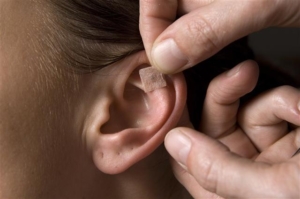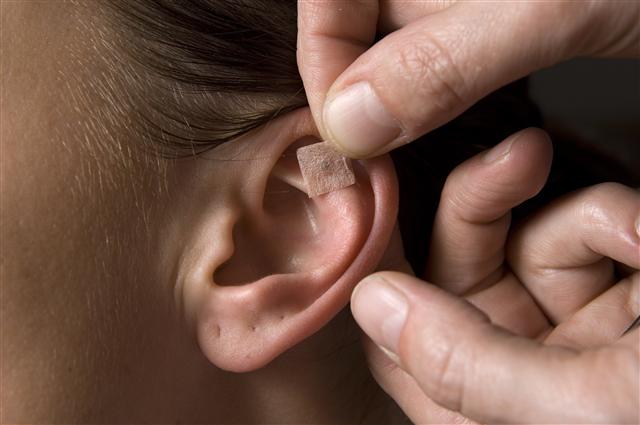 One of the most versatile and effective tools that we use at Seekers is ear acupuncture. We typically use needles to treat specific points we locate on each individual patient, but there are other ways to treat these points. Another approach, which we can use instead of needles or in combination with them, is ear seeds.
One of the most versatile and effective tools that we use at Seekers is ear acupuncture. We typically use needles to treat specific points we locate on each individual patient, but there are other ways to treat these points. Another approach, which we can use instead of needles or in combination with them, is ear seeds.
The use of ear seeds for healing was recently profiled online by CBS New York. This is old news for us, but it is nice to see our methods validated in a major media outlet. It seemed like a good time to review some key aspects of this treatment for those of you who already know and love your ear seeds. For the rest of you, I would like to explain this treatment in more depth. It is truly amazing.
Where does it come from?
Ear seeds are part of a comprehensive treatment system called auricular medicine. This was ‘discovered’ in the 1950s by Paul Nogier, a neurologist practicing in Lyon, France. And his discovery is an interesting story.
During the course of his regular clinical practice, Nogier noticed tiny scars on the ears of several of his patients. They told him they were treated by a local healer named Madame Barrin, who had cured them of their chronic low back pain.
Nogier had already studied acupuncture, so he recognized that this might be important. He was so curious about this unknown technique that he went to seek out Madame Barrin. She said she had learned it as a young girl, from a wanderer who had been passing through her father’s farm and was allowed to stay. She said she was ‘Mongolian’, and that she had since treated hundreds of people with the technique, most with lasting positive results.
Thus began Nogier’s quest. He started carefully examining every single one of his patients’ ears. He found tender points that he documented on a diagram of the ear, along with a list of the places in their bodies where they experienced pain.
How does it work?
Nogier’s first major insight was that there is a map of the body on the ear. Modern neuroscience has established the same kind of body map in the motor cortex of the brain, which is called a homunculus – which literally means ‘miniature man’. It is similar to the map used in reflexology to find and treat specific points on the feet. Modern imaging confirms that stimulating these ear points triggers neurons in a deep brain structure called the thalamus. The body map is the same.
His second major insight, which was apparently an accident, was even more important. While examining a patient’s pulse, he brushed past an area on their leg and felt a surge in the strength of the pulse wave. On closer examination, he observed this response whenever he approached the tender ear points he had discovered.
Why haven’t I heard about this before?
Nogier presented his findings at an international acupuncture conference in China, and the rest is history. He organized his findings into a formal system that he taught to hundreds of doctors in Europe and abroad. His students have gone on to treat patients, broaden his methods and teach others, conduct research and publish their work in dozens of clinical trials.
Clinical trials have found that ear acupuncture can reduce the need for pain medications during and after surgery. A specific protocol is being used around the world to treat opioid withdrawal and other brain-related disorders. But its massive potential still remains unrealized, because this simple, elegant technique is almost totally unknown.
How is this related to blockages?
This is because these points are like short circuits in the body’s computer that are linked to scars from previous injuries and trauma. This is because the tissues and nerves affected by infections, fractures, surgical scars, and even emotional traumas do not always heal completely. They can sometimes remain sensitive, even if they appear normal.
These areas where the nerves are sensitive are called disturbance fields, and the electricity they produce is different. Trained hands can literally feel these areas, because the electricity leads to vibrations in tissue. Disturbance fields can also be identified by changes in muscle strength, skin conductance, pupil dilation and other parameters. This is because when they are stimulated, they trigger a stress response.
What does this treatment feel like?
The treatment only takes a few minutes. The most important part is selecting the points on the ear that need it most. This involves using the pulse and examining the surface of the ear. When we find a ‘short circuit’, we carefully insert a tiny acupuncture needle into that point.
We can tell right away when we have hit the bullseye, because it hurts. In some cases, it hurts a lot, but it is usually manageable. For people who hate pain, we can skip the needle and go straight to the next step, which is the ear seed.
These are called seeds because they are actually seeds. Traditional Chinese Medicine has typically used the seeds of the Vaccinium plant. These tiny, dark, round balls are about 1mm in diameter, and each seed is stuck to a small, square piece of adhesive tape. This piece of tape is peeled off and stuck to the ear, so that the seed it the centre is touching the tender point on the ear that we want to treat.
Traditionally, it is recommended that these seeds remain in place for about three weeks. A small amount of glue can be applied around the tape to ensure that it remains in place.
What are you supposed to do with an ear seed?
You are supposed to use the seed to massage the tender point on your ear. We tell patients to hold it between their thumb and forefinger, and rub them back and forth until they find the most tender spot. The goal is to massage that tender spot by squeezing the fingers together to produce pain that is manageable. It is easier to synchronize the massage with the breath. Squeeze while inhaling, release while exhaling.
The more often you treat yourself, the better. Massaging the tender spot usually produces changes in the affected nerve after only 4-5 breaths. More is better, but repeating the massage throughout the day is just as important. I encourage patients to work with their seeds anytime they are sore or tired, anxious, or depressed.
If you are using natural health products, it is helpful to treat your ear points at the same time. It is also very helpful to treat them during exercise or while stretching or doing yoga. You can usually feel immediate changes in tight or weak muscles after playing with your seeds.
Why is this such a big deal?
An ear seed costs three cents. You can take as many doses as you like. There are no harmful side-effects, apart from the tenderness you feel in the ear. When combined with the right instructions, ear seeds can encourage mindful breathing and more regular self-care. They are easy to use, and are very portable.
As a doctor who has done medical missions in developing countries, I have a special fondness for ear acupuncture. A backpack full of ear seeds can treat thousands of people, many of whom would not otherwise have access to healthcare. In the hands of a healthcare provider who knows how to find and treat blockages, the potential is enormous.
After years of using these methods, I sincerely believe that finding and treating these hidden scars is the single most important discovery in the history of medicine. While there are literally thousands of practitioners around the world who apply these various techniques, these blockages are virtually unknown to modern medicine.
Creating awareness of this massive undiscovered part of science, and how it relates to vibrational medicine, has become my life’s work. When this happens, it will literally transform healthcare and relieve suffering for millions of people.

